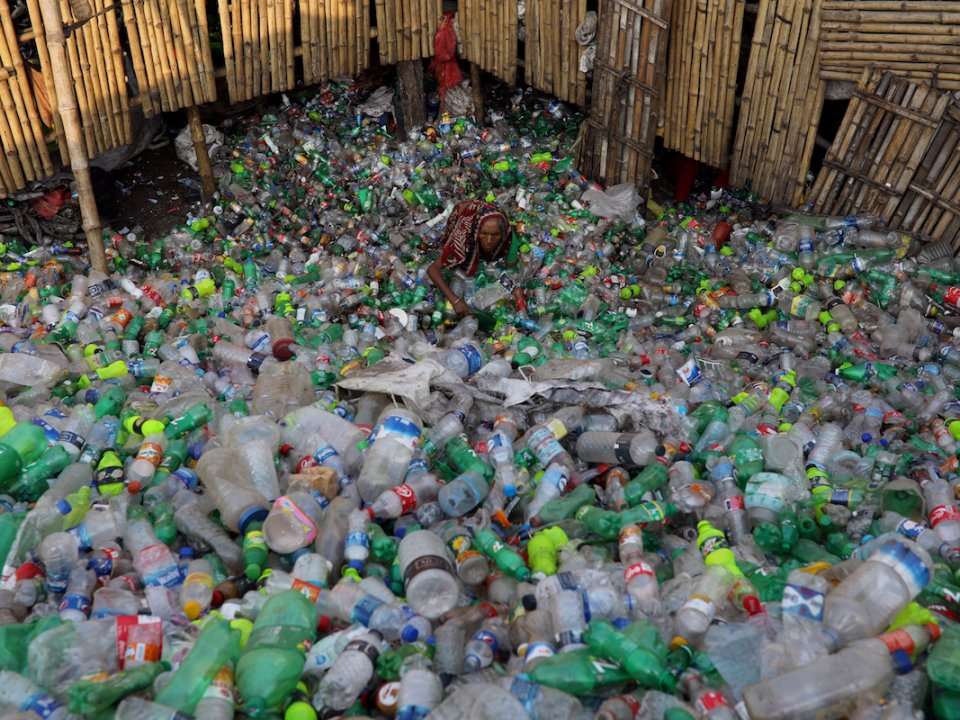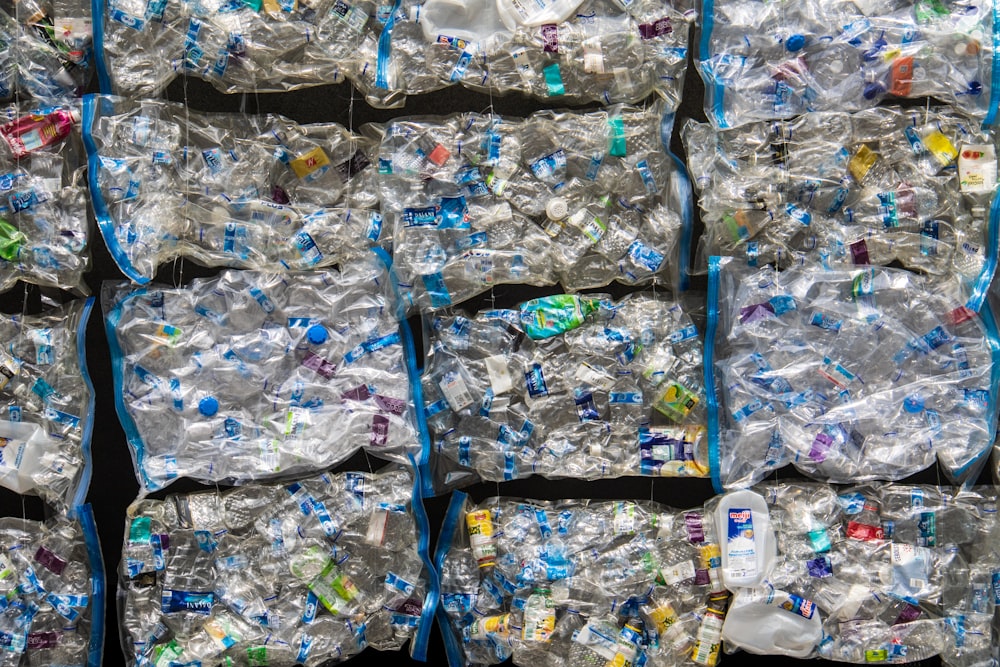Editor’s Note: FII’s #MoodOfTheMonth for July 2021 is Sustainability. We invite submissions on the diverse aspects of sustainability throughout the month. If you’d like to contribute, kindly email your articles to sukanya@feminisminindia.com
Ever since China implemented the National Sword Policy, banning the import of plastic waste from “richer, more developed” countries, the observant reader would have noticed a gradual spike in the conversations related to plastic waste.
Like a domino effect, the ban set off a mad scramble by consumer product companies promising to make “100% recyclable, reusable, renewable” packaging by the end of the decade. The alacrity of this reaction is hardly surprising, after all, most of these companies and their financiers are based in these same ‘developed’ countries- the Global North.
plastics make a quick transition from being a material of use, to waste that serves no further purpose for the user. Once entrusted to the dustbin, plastic conveniently seems to disappear from our immediate lives. But we can still see it outside our homes, literally floating around. But by then, it is disembodied from us
Plastic waste though, is not only a rich-country problem. Nor is it recent. We, in the Global South, are vast markets and recipients of the goods and services of large transnational companies. In the decades following our exciting union with a ‘globalised world’, our teeming masses have been transformed from regular people to ‘untapped consumers’.
We are the ‘potential markets’ to be weaned from traditional products, towards mass-manufactured versions that come packaged in plastic. The result – a plastic wasteland.

Let us do an easy exercise: look around you in the room or the space that you are in. Now count all the products that use plastic, either as a material component or as packaging. This will help you visually affirm that in India, everything from kitchen staples, to personal and household care, as well as electronic and analogue appendages is all either packaged in plastic, or have plastic components. Mostly it is because plastic is such a “perfect” material – flexible, durable and exceedingly economic.
There is no Indian who has not grown up seeing plastic waste. It has been the constant mosaic of our lives, strewn along train tracks or stuck in riverine brambles. Yet, it seems as if neither the drains gutted with plastic bags, nor the rag-pickers looking for empty PET bottles are on us, despite all of it being the dregs of our existence
However, plastics make a quick transition from being a material of use, to waste that serves no further purpose for the user. Once entrusted to the dustbin, plastic conveniently seems to disappear from our immediate lives. But we can still see it outside our homes, literally floating around. But by then, it is disembodied from us.
There is no Indian who has not grown up seeing plastic waste. It has been the constant mosaic of our lives, strewn along train tracks or stuck in riverine brambles. Yet, it seems as if neither the drains gutted with plastic bags, nor the rag-pickers looking for empty PET bottles are on us, despite all of it being the dregs of our existence.
Perhaps that is why we care so little about the frustrating difficulty of estimating how much plastic waste is generated in the country. People often say, “data is the new oil”. That is because they have access to it. For the rest of us, data is the new oil only because it lies hidden and inaccessible under hard desert rocks – locked and vaulted in links and sub-links, poorly referenced and indexed.
Also read: Jugaad—A Way To Reduce Plastic Waste & Keep Our Privileges In Check
Data and information on anything that matters, is accessible only to the privileged or the obsessed. This makes the estimation of plastic waste inaccessible to most of us.

It is said that the Emperor Akbar had a witty and wise minister, Birbal. One day, the emperor wanted to stump his clever advisor and so he asked him a question that Akbar knew was un-answerable.
“Tell me, O Birbal, how many crows do we have in my fair city of Delhi?”
“O Shahenshah, there are five thousand two hundred and thirty-three crows”
“Ha! How dare you give an answer so quickly and with such confidence? You mock me! What if I get my soldiers to count the crows and they find ten thousand instead?”
“O Shahenshah, I dare not mock you. This is the correct answer. If you find more crows, why those are the relatives of our crows, come to visit them, perhaps from Agra and across the pleasant Yamuna”
“And what if there were lesser than you said?”
“O Shahenshah, I forgot to mention that our crows also occasionally visit their relatives!”
I share this anecdote because estimating plastic waste in India, or indeed anywhere else is quite like this. Much depends on what plastic is used for. In India, over 50% of the plastic that is produced is used in packaging, which means it becomes waste almost immediately. In other cases, such as when a harder version of plastic is used to make the water storage tanks, the waste is generated a decade or two later.
Unlike information though, plastic waste does not stay hidden. It exists and will continue to grow, eventually breaching the invisible wall that separates us from the environment and people who currently bear the brunt of our waste
Much also depends on the source of data and the methodology of estimating the waste. According to the Central Pollution Control Board (CPCB), India generated 3.4 million tonnes of plastic waste in 2018-19. This consolidated figure for the country is officially released by the CPCB, after it collects data from 35 state pollution control boards and union territory pollution committees. However, such submission and timelines are often erratic.
Take the more recent period of 2019-20 when only 23 states or union territories submitted their reports. According to this submission, the plastic waste generated per annum for India was only 1.8 million tonnes.

However in 2010-12, the CPCB used a sampling-based methodology to estimate plastic waste in 60 major cities. This survey estimated that India generated about 4059.2 tonnes of plastic waste per day (approximately 1.5 million tonnes per annum). It must be noted that this was almost a decade ago, when the country was consuming 6.8 million tonnes of plastics.
As we continue to clog drains, choke marine creatures, inhale the dioxins emitted by burning plastic, and start incorporating microplastics into foetal skeletons, I hope we constantly ask one question to ourselves – What are we going to do about this?
Given the threefold growth in plastic consumption over the last decade, it is remarkable that recent estimates of plastic waste are less than two times this base. Indeed, this gives credence to the general understanding that official estimates are typically at the lower end of a range.
Industry estimates like the one released by the Indian Plastics Industry in 2019, are higher and possibly closer to reality. Their estimate for 2018 was 6.6 million tonnes of plastic waste generated per annum. This is based on a simple calculation that assumes that approximately 42% of the plastic consumed in a year, becomes waste.

Another way to estimate plastic waste is by using a percentage of plastic share in municipal solid waste. This share of plastic has been variously estimated at between 6.92% according to the CPCB or even 9.5% used by Law et. al. in a Science magazine article. I would go with the higher share because it is evident from various studies, including a very interesting audit of plastic waste in India, by the Global Anti-Incinerator Alliance that shows plastics now constitute almost half of our non-organic waste.
The realistic range of plastic waste I infer, lies between the industry estimate and that of the Un-Plastic Collective, an initiative cofounded by WWF-India, UNEP and the Confederation of Indian Industry (CII). The Un-Plastic Collective’s estimate of plastic waste in 2019 was 9.5 million tonnes, although they do not clarify how they got to this figure.
Also read: We Produce 9000 Tonnes Of Sanitary Waste Every Year | #ThePadEffect
On the higher side of the range are un-dated estimates from the United Nations Development Programme (UNDP), which claims 15 million tonnes. There is also an astonishingly high estimate from Law et. al. where the researchers estimate India’s plastic waste for the year 2016 was 26.33 million tonnes. This variance is likely explained by the high projection of Indian municipal solid waste that was used in their estimation.

Estimates of emissions into the environment are never absolute. There will always be an element of uncertainty. What is more important is to constantly clarify and review the methodologies used to make these estimates.
Unlike information though, plastic waste does not stay hidden. It exists and will continue to grow, eventually breaching the invisible wall that separates us from the environment and people who currently bear the brunt of our waste. As we continue to clog drains, choke marine creatures, inhale the dioxins emitted by burning plastic, and start incorporating microplastics into foetal skeletons, I hope we constantly ask one question to ourselves – What are we going to do about this?
Dechen has worked for many years in the corporate sector (including a longish stint at a beverage company closely associated with plastic packaging). She is aware and appreciative of business metrics, operations and drivers. However, she also realises that a purely business lens is no longer sustainable. She passionately believes in the need to make a course correction from our current zombie-state, before it is too late. You may find her here
Featured Image: Ritika Banerjee for Feminism In India




